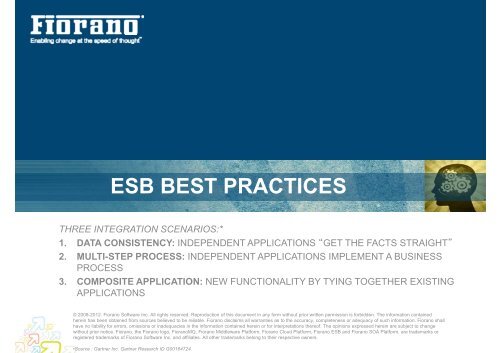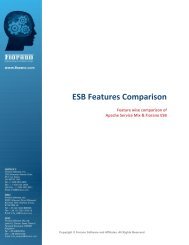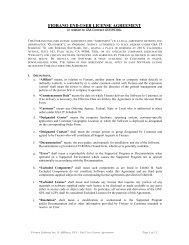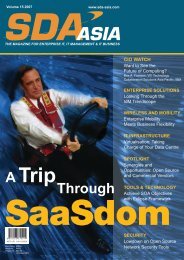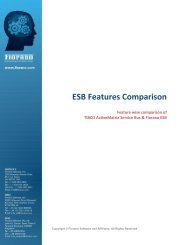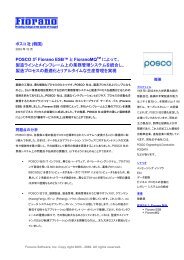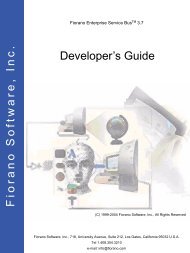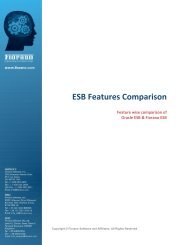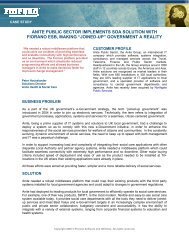ESB BEST PRACTICES - Fiorano
ESB BEST PRACTICES - Fiorano
ESB BEST PRACTICES - Fiorano
Create successful ePaper yourself
Turn your PDF publications into a flip-book with our unique Google optimized e-Paper software.
BUSINESS PROCESSES BECOME AGILEWHEN IMPLEMENTED AS SERVIC<strong>ESB</strong>usiness Perspectives– Simplification– Elimination– People– Process PerformanceMeasurement– Simulation modeling– Agility–etc.Systems Perspectives– Working Software– Reliability– Configuration Management– Scalability / Performance– Reusability– Speed of Delivery–etc.With SOA – Processes Can Be Layered on Top of Existing InfrastructureSlide 4
INTRODUCTION TO SOA – Message OrientedMiddleware (MOM)CHALLENGES• Easy Inter-Operability• Common Data Model for integration• Robust Process Management• Scalability and High-Availability• Distributed Services Management –Real time configuration changes• Reusability of Components & Servicesin an effective IDE• Portable Adapters• Cost, Speed, Quality & ControlSlide 5
INTRODUCTION TO SOA - WEB SERVICESCHALLENGES• Suffer from incomplete and competing standards definitions that might not ensure easyinteroperability across different implementations• Interoperabilty SOAP Only binding for HTTP; no bindings for SMTP, JMS “SOAP encoding”: XML ObjectsRosettaNet, EDIINT: no SOAP SOAP 1.1 1.2 (W3C)• WSDL: RPC/Encoded vs. Document/Literal• Do not offer a complete package but provide only the functionality of access and invocationleaving majority of the development work to the user• Business Semantics – Additional tools needed for Orchestration & Choreography• SecurityHTTPS is not enough No agreement regarding attachments S/MIME in RosettaNet and EDIINT Single Signon• Transactional Integrity• Reliable Asynchronous Message Handling WS-Reliability (IBM, MS) vs. WS-ReliableMessaging (OASIS)• Transformation ServicesSlide 6
DEMYSTIFYING THE <strong>ESB</strong>
DEMYSTIFYING <strong>ESB</strong>Enterprise Service Bus evolved out of SOA• IT Components can be accessed as services• Defined form of invocation and entry points to service• Business process - Event-driven/Asycnhronous Inovcation of Services• Composite Application – mix of existing and new componentsSlide 8
FUNDAMENTALS OF SOA FOR INTEGRATIONSlide 9
DEMYSTIFYING <strong>ESB</strong>Enterprise Service Bus – Standards based Integration• Communication and data routing (JMS)• Data protocols (XML)• Transformation (XSLT)• Content Based Routing g( (CBR)• Connectivity (via JCA, .NET, Web-Services, REST)• Web-Services; REST-baed Services• Security• Pre-built Business Components and ConnectorsRelated Infrastructure and Concepts - not explicitly part of an <strong>ESB</strong>• Business Process Management (BPM)• Business Process Modelling (BPMN, YAWL or Equivalent)• B2B – trading partner managementSlide 11
SERVICE-ORIENTED ARCHITECTURE (SOA)FLEXIBLE, EXTENSIBLE INTEGRATION• Design methodology for distributed systems• Applications expose functionality through service interfaces• Loosely-Coupled• Platform and language neutral• Impervious to implementation changes• Coarse-Grained- business level Interfaces• Asynchronous• No single points of failureSlide 14
DEMYSTIFYING <strong>ESB</strong>Slide 15
DEMYSTIFYING <strong>ESB</strong>Slide 16
EXAMPLE: BUILD ON EXISTINGINFRASTRUCTUREBusiness Needs• Want to replace Broker and MQdue to high TCO and complexity• Reduce cost of new distributioncenters, with guaranteedmessaging• Need web-service access todata• Need choreography of services• Integrate t new applications fasterand cheaperSlide 17
EXAMPLE: BUILD ON EXISTINGINFRASTRUCTURESolution•Services Oriented Integration•Reuse messages/events withexisting MQ•Incrementally add transformation,orchestration, distributedmanagement•Gain immediate value from higherROI projectsSlide 18
DEMYSTIFYING <strong>ESB</strong><strong>ESB</strong>’s are best suited for:• Projects that t will mix heterogeneous application services (for example,Microsoft or Java portals with disparate Java or Microsoft server backends)• Enterprises that want to start with a basic SOA and add other featureslater, as the implementation evolves• Enterprises that want to assemble their own best-of-breed breed comprehensiveintegration suites• Mix and match off-the-shelf adapters, BPM, B2B, and BAM tools fromother vendors• Distributed services (written in different programming languages) runningon disparate nodes on different operating systemsSlide 19
DEMYSTIFYING <strong>ESB</strong>Types of <strong>ESB</strong>:1. <strong>ESB</strong>s based solely on SOAP -Webservices brokers (WSBs)2. Multiprotocol <strong>ESB</strong>s that support JMS,Web services and othercommunication mechanismsSlide 20
<strong>ESB</strong> - VENDORS (2012)Support SOAP/HTTP and additional protocols guaranteed delivery, publishand-subscribeoften following the JMS standard<strong>ESB</strong><strong>Fiorano</strong> <strong>ESB</strong>IBM WebSphere <strong>ESB</strong>Oracle Service BusTIBCO ActiveMatrixService BusMicrosoft BizTalk ServerCommentsNative support for JMS, Peer-to-Peerarchitecture; REST-based ServicesBPM-centric Hub/Spoke architecture; Nonnativesupport for JMSBased on BEA acquisition, BPM-centricHub/Spoke architectureNatDistributed Architecture, but heavyweightand BPM-centric; native JMS support;Monolithic EAI broker - not a true <strong>ESB</strong>,Microsoft environment centric.Slide 21
<strong>ESB</strong> IMPLEMENTATION METHODOLOGIES
3 BASIC INTEGRATION PATTERNSSlide 23
STEP 1– REQUIREMENTS GATHERINGDATA CONSISTENCY – DATABASE SYNCHRONIZATIONThe technical requirements of ABC Corporation can be summarized as• Data needs to be replicated across multiple data centers asynchronously using a Message Bus.• Any changes made to the Oracle Database instance in Geneva need to be reflected (based oncertain selection criteria) in either the Sybase database instance or the MSSQL database instancelocated in San Francisco and St.Louis respectively.• The data needs to be transformed from the source table data format to target table data format(s).• All data transfers need to be secureKey Characteristic: the data flow between steps is asynchronous and one-waySlide 24
STEP 1– REQUIREMENTS GATHERINGMULTI STEP PROCESS – ORDER FULFILLMENTCompany X runs an online market place for electronics products. Orders are accepted over theweb and saved in an Oracle DB. To process an order, the company needs to perform creditcardverification using a third party hosted credit card gateway and then send out orders tosuppliers over email. The supplier sends back an acceptance or rejection notification of theorder (along with expected delivery schedule) by a return email. This information needs to beupdated in the Oracle DB, so that the customer can track the status of the order online.Key Characteristic: the data/event flow between steps is asynchronous and one-waySlide 25
STEP 1– REQUIREMENTS GATHERINGCOMPOSITE APPLICATION – QUOTE TO BINDEnd to End business process for opening a new insurance policy that includes Capture ofcustomer information, Risk Evaluation requestor, Processing of the Application,Development of a Price Quote and finally, a Response (Quote) to the user.Key Characteristic: The completion of each step is predicated on the completion of the nextstep and the calling sequence is request/reply between steps.Slide 26
STEP 1– REQUIREMENTS GATHERINGBUSINESS – DATA SYNCHRONIZATION• Data synchronization for Disaster recovery planning and business continuity,Content distribution, Backup consolidation, and Server migration• Completely eliminate all manual data synchronization without having to stopthe system to accommodate new outlets or changes to the tables in thesource or target systems• Business process monitoring Dash Board• Add new retail outlets• Business users should be able to rapidly create and deploy businessprocesses• Timelines – immediate• Reduce development, maintenance costsSlide 27
STEP 1– REQUIREMENTS GATHERINGTECHNICAL/SYSTEMS – DATA SYNCHRONIZATION• TECHNICAL• High Level Business process representation – ideally, the model shouldmap as rapidly as possible to the final application solution• Databases (SQL, Oracle, DB2 and files) across disparate OS• Event/Data flow representation• Intended users –• Business Analyst (Choreography and Execution)• System Administrator (setup, configuration, data transformation)• SYSTEM• Platforms and Operating Systems• Overall network topologySlide 28
STEP 1– REQUIREMENTS GATHERINGOUTPUT DOCUMENTS• High-Level Design documents that address the integration requirements(business & technical)• Document all the identified data and process flows• Create a list of different networks, and the servers available in each of thesenetworks• Recommended hardware specifications for the specific <strong>ESB</strong> product• Any 3 rd party software that is essential to the functioning of the <strong>ESB</strong>Slide 29
STEP 2 – IDENTIFYING “MUST HAVE” FEATURESDATA CONSISTENCY• Architecture• SOA ? (Hub & Spoke, Peer to Peer, Brokered Peer to Peer) Brokered P2P with store and forward at end points of the network Automatic reconnects in case of network failures In-built store-and-forward• Supported Standards XML, JCA, CBR• Message Bus (Asynchronous, Transformation, etc) Asynchronous, Transformation (at source or destination)• Support for Distributed Applications (Compose, Execute and Monitor distributedApps) Location and Technology transparency, Intelligent routing, Single pointof control, Deployment support• Connectivity services ( Web services,J2EE Connectors, JMS, WebSphere MQ) JMS, Database Connectivity (JDBC)Slide 30
STEP 2 – IDENTIFYING “MUST HAVE” FEATURESDATA CONSISTENCY• Administration / Deployment Single point of control Dynamic changes to application processes Single point of control Remote access capability Start / stop facilities Manual routing support Tracing Message editing• Monitoring Problem determination Problem prediction Internal and external support Support for enterprise management frameworksSlide 31
STEP 2 – IDENTIFYING “MUST HAVE” FEATURESDATA CONSISTENCY• Robustness (Service and the Infrastructure level) Fault avoidance Fault tolerance• Scalability and Performance (Service and the Infrastructure level) Asynchronous messaging Multi-threading Load balancing Large data handling• Security (Infrastructure and Application level) Access control Information security Tools usageSlide 32
STEP 2 – IDENTIFYING “MUST HAVE” FEATURESDATA CONSISTENCY• Breadth of Connectivity (Configure, Modify, Connect with other Adapters) DBMS access (Oracle, SQL, DB2, etc) Legacy systems (Mainframe Applications) Application servers .NET COM / CORBA - Multi-Language Adapters WebServices (Publisher and Consumer)• Tools Configuration (Business Processes, Services, Infrastructure) Incremental deployment Lifecycle supportSlide 33
STEP 3– COMPONENTIZING BUSINESSPROCESSES• Component/Service/Business Service – Definition• Fine-Grained Components - Issues• Coarse Grained Components – Advantages• Pre-built Components - Ease the rapid deployment of processes• User Defined Components – Best practices• Reusing existing resourcesSlide 34
STEP 3 – COMPONENTIZING BUSINESS PROCESSESFINE GRAINED COMPONENTS - ISSUES/PROBLEMS• Typically represent function call (static input and outputs)• Low reusability (impossible to build a general purpose Database Adapterusing a “Fine Grained” component tdesign approach)• Development overheads (tight coupling between client and component)• Change of service functionality needs re-coding (Static data formats forinput and output)• Does not map well to business process composition• Synchronous invocation of function calls• Skilled developers needed to use fine-grained componentsSlide 35
STEP 3 – COMPONENTIZING BUSINESS PROCESSESCOARSE GRAINED COMPONENTS - ADVANTAGES• Represents a high level business component• Easy to Orchestrate and/or Choreograph business processes using thesecomponents• Reusable across business process (changes required only in design timeproperties)• Dynamic data formats for input and output• Synchronous & Asynchronous invocation• Low development cost (middleware is hidden)• Business Analysts can orchestrate business processes without ITInterventionSlide 36
STEP 3– COMPONENTIZING BUSINESS PROCESSESENTERPRISE SERVICES - REUSABLE, BUSINESS LEVEL BUILDING BLOCKS• Coarse-Grained Level of abstraction easily understood by business people• Event-Enabled Interfaces Easily composed into Distributed, Event-driven Processes• Multi-Language No development restrictions• Generalization of Web-Services Standards-based WSDL interfaces• REST- based Services The document is the interface No central state-management; all state carried in messages/documentsSlide 37
STEP 3 – COMPONENTIZING BUSINESS PROCESSESSERVICE INTERFACESlide 38
STEP 3 – COMPONENTIZING BUSINESS PROCESSESCOARSE GRAINED COMPONENTS“A component is a non-trivial, nearly independent, and replaceable part of asystem that fulfills a clear function in the context of a well-defined architecture.A component conforms to and provides the physical realization of a set ofinterfaces."- Philippe Krutchen, Rational Software• Well defined interfaces & contracts• Provides implementation of interfaces• Coarse grainedSlide 39
STEP 3 – COMPONENTIZING BUSINESS PROCESSESCOARSE GRAINED COMPONENTS"A software component is a unit of composition with contextually specifiedinterfaces and explicit context dependencies only. A software component canbe deployed d independently d and is subject to third-party t composition."- Clemens Szyperski, Component Software• Developed, tested and deployed in complete isolation• Can be configured for different environments at deployment time• Supports contextual dependenciesSlide 40
STEP 3 – COMPONENTIZING BUSINESS PROCESSESCOARSE GRAINED COMPONENTS"A component is a physical and replaceable part of a system that conforms toand provides the realization of a set of interfaces...typically represents thephysical packaging of otherwise logical elements, such as classes, interfaces,and collaborations."-Grady Booch, Jim Rumbaugh, Ivar Jacobson• Includes physical packaging of files, executables, jars, dlls, etc• Aggregation of classes & functions into a complete, reusable functionality• Higher level of reusability than ClassesSlide 41
STEP 3 – COMPONENTIZING BUSINESS PROCESSESPRE-BUILT SERVICES• Services Bridges Database/File Adapters Web/WebServiceAdapters Routing (flow services) Transformation Signing, encryption,encoding Services• Adapters Middleware ApplicationSlide 42
STEP 3 – COMPONENTIZING BUSINESS PROCESSESUSER DEFINED COMPONENTS – <strong>BEST</strong> <strong>PRACTICES</strong>• Identifying set of user defined services• Choosing Appropriate programming language(Java, C, C++, C#, Perl, Python, JavaScript etc)• Identifying input and output ports(dynamic or static)• Custom Property Sheet(Design & runtime properties)• Exception and Error Handling mechanisms• Tracing and Logging supportTrace Modules and trace levelsLogging details• Transaction supportLocalGlobalSlide 43
STEP 3 – COMPONENTIZING BUSINESS PROCESSESUSER DEFINED – <strong>BEST</strong> <strong>PRACTICES</strong>• Each component has specific design and runtime properties that need tobe properly configured, without which the integration process will fail• E.g. Database configuration illustrated below.Slide 44
STEP 3 – COMPONENTIZING BUSINESS PROCESSESUSER DEFINED – <strong>BEST</strong> <strong>PRACTICES</strong>• Identify and configure input and output ports. Based on the configuration of theCPS (Component property sheet), each component generates schemas on bothinput and output ports.• The schema defines the data format (XSD, DTD, XML) for input and outputtmessages.Slide 45
STEP 3 – COMPONENTIZING BUSINESS PROCESSESUSER DEFINED – <strong>BEST</strong> <strong>PRACTICES</strong>• Ensure the <strong>ESB</strong> supports error-handling atthe component (adapter) level• Each component should have an error-handling configuration (configured via theCPS) to allow predefined actions to be setfor each type of error-condition• For instance, if you wish to stop messageprocessing when an error occurs, set the“Stop Service” action: this ensures thatincoming messages are queued up at theinput port; such messages are processedonly once the component is restartedSlide 46
STEP 3 – COMPONENTIZING BUSINESS PROCESSESUSER DEFINED – <strong>BEST</strong> <strong>PRACTICES</strong>• Tracing and Logging support – essential to debug integration processes in a distributedenvironment. Identify modules to set trace/log levelsView/change via Studio or Web-based b DashboardSlide 47
STEP 3 – COMPONENTIZING BUSINESS PROCESSESUSER DEFINED – <strong>BEST</strong> <strong>PRACTICES</strong>• Transaction support Local (Client level transactions): typically associated with databases, allowingusers to define boundaries across a set of queries and/or input messages Global (XA): must be handled at the component level Compensating transactions: mapped onto an <strong>ESB</strong> flow; on failure of a certainoperation, a compensating transaction undoes the previous changes• Performance Requirements Expected transaction throughput: can be done by running flows in parallel ondifferent peer servers and load balancing incoming messages across thesepeers Multi-threading support: supported at the component level by increasing thenumber of JMS Sessions on the input port of a component• Synchronous/Asynchronous; the <strong>ESB</strong> must handle both synchronous andasynchronous end-points, both for inbound and outbound requests (JMSIn,JMSOut, WSStub, and WSConsumer)Slide 48
STEP 3 – COMPONENTIZING BUSINESS PROCESSESUSER DEFINED – <strong>BEST</strong> <strong>PRACTICES</strong>• Tools for service development – check for “online” (connected to the server) and “offline”(disconnected mode) development support• Ideally, the <strong>ESB</strong> will support IDE plug-insSlide 49
STEP 3 – COMPONENTIZING BUSINESS PROCESSESREUSING EXISTING SERVICES – <strong>BEST</strong> <strong>PRACTICES</strong>• The <strong>ESB</strong> must allow custom-component component development in multiple languages (Java,C, C++, .NET, scripts, etc), together with:• Adapters to Web-Services, REST, COM, EJB, CORBA, RMI, etc• Reuse of business processesSlide 50
STEP 4– DEFINING DISTRIBUTED <strong>ESB</strong>PROCESSES• Control vs. Data Flowo Data flow incorporates both synchronous and asynchronous message-flow;more general purpose than pure control flow• Business Process Orchestrationo Typically implies a central orchestration engineoFor distributed <strong>ESB</strong>s, central orchestration is a bottleneck; ChoreographedEvent-flow processes with a graphical representations that map directly to thephysical implementation offer greater flexibility and generality• Event Warehousing• Security• Logging, Tracing & Alerts• Data format impedance mismatch• Configuring Business processes for failover• Configuring Business processes for performanceSlide 51
STEP 4 – DEFINING DISTRIBUTED <strong>ESB</strong> PROCESSEVENT PROCESS• Event Driven Business Process or simply “Event Process”• Drag and drop approachSlide 52
STEP 4– DEFINING DISTRIBUTED <strong>ESB</strong> PROCESS<strong>ESB</strong>USINESS PROCESS CHOREOGRAPHY• Composition using pre-built services• Data routing• Control information• Data transformation• Identifying Node Names• Configuring Service Design time propertiesSlide 53
STEP 4– DEFINING DISTRIBUTED <strong>ESB</strong> PROCESSESDOCUMENT TRACKING• Document tracking is a critical requirement essential to audit the incoming andoutgoing data flowing through each component; message warehousing.Slide 54
STEP 4 – DEFINING DISTRIBUTED <strong>ESB</strong> PROCESSESROLE BASED SECURITY• The <strong>ESB</strong> must support ACL-based security. Users can be assigned different rolesand each role has different permissionsSlide 55
STEP 4– DEFINING DISTRIBUTED <strong>ESB</strong> PROCESSESLOGGING, TRACING & ALERTS• To facilitate debugging in a distributed environment, the <strong>ESB</strong> should ideally allowalerts to be set depending on trace and log levelsSlide 56
STEP 4– DEFINING DISTRIBUTED <strong>ESB</strong> PROCESSESDATA FORMAT IMPEDANCE MISMATCH• Transformation is fundamental to <strong>ESB</strong> processes; powerful XSLT visualtransformation tools are mandatory; manual XSLT injection is a strong plusSlide 57
STEP 4– DEFINING DISTRIBUTED <strong>ESB</strong> PROCESSESCONFIGURING BUSINESS PROCESSES FOR FAILOVER• State failover for services: if a Service/Component fails on a given machine, it shouldbe relaunched on another (failover) machine• Server level failover: if the <strong>ESB</strong> server fails, a pre-configured backup should seamlesslytake overSlide 58
STEP 4– DEFINING DISTRIBUTED <strong>ESB</strong> PROCESSESCONFIGURING BUSINESS PROCESSES FOR PERFORMANCE• Identifying Parallel data flows• Dynamic rerouting of data based on load• Identifying Heavy-weight services (80/20 Rule)• Running multiple instances of “heavy weight” services on different nodes• Sub-Flows and Sub-Processes for effective business process execution• Log/Trace level optimization• Event tracing optimizationSlide 59
STEP 4 – DEFINING DISTRIBUTED <strong>ESB</strong> PROCESSCONFIGURING BUSINESS PROCESSES FOR PERFORMANCE• Load-balancing should be possible at the Service/Component level• E.g. based on a preconfigured weightage, incoming messages are distributed tothe output ports of a distribution componentSlide 60
STEP 5 – DEPLOYING <strong>ESB</strong> PROCESSES• Deployment - what does it mean ?• Identifying Network Domain/Topology• Manual Services vs. Auto-Launched Services• Security issues for Deployment• Service Development Languages and PlatformsSlide 61
STEP 5– DEPLOYING <strong>ESB</strong> PROCESSESWHAT DOES IT MEAN?• Deployment Descriptors – are typically used to hold execution parameters anddeployment information of components, including dependent services, resources,etc. The <strong>ESB</strong> uses such descriptors to deploy components at runtime.Slide 62
STEP 5– DEPLOYING <strong>ESB</strong> PROCESSESMANUAL VS AUTO LAUNCHManual Services• Executed externally to the <strong>ESB</strong> (Servlets, EJBs etc)• Combination of managed and unmanaged components• Managed Components like: A Webservice deployed in a Webservice container An EJB deployed in J2EE container A COM Object deployed in COM+ server A CORBA based server Object deployed in an ORB Windows Service• Unmanaged Components like: Java executable archive A C/C++ executable Legacy Application running in a mainframe environment A Unix shell program (functioning within a pipe-and-filter stylearchitecture)Slide 63
STEP 5– DEPLOYING <strong>ESB</strong> PROCESSESMANUAL VS AUTO LAUNCHAuto Launched Services• Native <strong>ESB</strong> services: managed and launched by <strong>ESB</strong> containers• Auto start/stop and restart of these services• Connectivity management• Fine grained monitoringSlide 64
STEP 5– DEPLOYING <strong>ESB</strong> PROCESSESSECURITY ISSUES• Ideally, the <strong>ESB</strong> should allowflexible Deployment Managerto control and manage servicedeployment• For instance, the <strong>ESB</strong> shouldenable users to allow/restrictthe execution of componentsthat t belong to certainintegration processes oncertain machines across thenetwork• Useful for fine-grained controlof the integration process aswell as for SecuritySlide 65
STEP 6– LAUNCHING & MONITORING <strong>ESB</strong>PROCESSES• Remote Launch of Business Process• Monitoring state of Application and all its associated service instances• Runtime hooks to determine state t of service• Real-time data debugging• Business Process Monitoring SNMP, JMX etc Monitoring of ServersSlide 66
STEP 6– LAUNCHING & MONITORING <strong>ESB</strong>PROCESSESLaunch of <strong>ESB</strong> processes• Remote Launch of <strong>ESB</strong> Services• Service Instantiation On-demand/On-Event Instantiation Auto Instantiation• Re-Launch of Business Process Auto re-launch on different set of nodes Rules based re-launch of business processSlide 67
STEP 6– LAUNCHING & MONITORING <strong>ESB</strong>PROCESSESMonitoring the state of an Integration flow and its associated service instances Local Queue (message) Monitoring and ManagementIdentify performance/scalability bottlenecks in real time by checking the number ofbacked up messages on input queues Identify parallel flows in the IntegrationSlide 68
STEP 6– LAUNCHING & MONITORING <strong>ESB</strong>PROCESSESEnsure the <strong>ESB</strong> supports runtime hooks to determine the state of a particular service Runtime tracing and Logging Sub-Flows to handle Error conditions Alert HandlersSlide 69
STEP 6– LAUNCHING & MONITORING <strong>ESB</strong>PROCESSESReal-time Message Interception– breakpoints can be set to view content of ‘in-flight’ messages (payload, properties)– facilitates debugging of distributed integration processesSlide 70
STEP 6– LAUNCHING & MONITORING <strong>ESB</strong>PROCESS<strong>ESB</strong>usiness Process Monitoring‣ SNMP, JMX etc‣ Monitoring of Servers Heap usage Backlog monitoring Performance monitoringSlide 71
STEP 6– CHANGE MANAGEMENT &VERSIONING• Dynamic Extensions to Business processes Static vs. Dynamic Impact Analysis Extend Business process to include new services Extend Business process to include data services with different dataformats Optimize Business process for performance, scalability Extend Business processes to handle network configuration changes• Service and Application VersioningSlide 72
STEP 6– CHANGE MANAGEMENT &VERSIONING• Configuration Management Moving from one stage to another (QA to Deployment) Moving from one environment to another (customer to internal testing)• Extension to Business process Updating Data Consistency Application to include a different datacenter• Change to Business Process Flexibility to adapt to new technologies (WebService instead of a C++stand alone Application)Slide 73
STEP 6– CHANGE MANAGEMENT &VERSIONINGService and Application Versioning• Manage and maintain multiple versions of services along with Labels• Quickly allow migration from one service version to anotherSlide 74
STEP 6– CHANGE MANAGEMENT &VERSIONINGConfiguration Management• Moving from one stage to another (e.g. Development to QA, QA to Staging,etc.)• Point and click-operation: the user should be allowed choose the targetenvironment configuration in a single operation, without using multiple scriptsSlide 75
PUTTING THEORY TO PRACTICE
TECHNOLOGY HYPE IS CONFUSING THE ISSUES WITHOUTPROVIDING A CLEAR PATH FORWARD• Need to choose standards that work today and will evolve for future• Solve the real integration problem – more than a Proof of Concepts• Must build incrementally on top of existing systemsSlide 77
STANDARDS REDUCE COSTS BUT…FUNDAMENTAL PROBLEMS REMAIN!• Business Person’s View High-level model of business process flow• IT Level View Implementation flow differs substantially from business process view• Impedance mismatch creates fundamental problems Implementations have too many “moving parts” Business-level change requirements difficult and time-consuming toimplementSlide 78
THE FUNDAMENTAL PROBLEM –DIVERGENT BUSINESS TECHNOLOGYSlide 79
A CHANGE IN BUSINESS PROCESSSlide 80
IS NOT EASILYMAPPED TO IMPLEMENTATION LEVELSlide 81
FIORANO <strong>ESB</strong>PEER-TO-PEER <strong>ESB</strong>Slide 82
THANK YOU!For more details please visit: www.fiorano.com© 2008-2012. 2012 <strong>Fiorano</strong> Software Inc. All rights reserved; Reproduction of this document in any form without t prior written permission i isforbidden. The information contained herein has been obtained from sources believed to be reliable. <strong>Fiorano</strong> disclaims all warranties as tothe accuracy, completeness or adequacy of such information. <strong>Fiorano</strong> shall have no liability for errors, omissions or inadequacies in theinformation contained herein or for interpretations thereof. The opinions expressed herein are subject to change without prior notice.<strong>Fiorano</strong>, the <strong>Fiorano</strong> logo, <strong>Fiorano</strong>MQ, <strong>Fiorano</strong> Middleware Platform, <strong>Fiorano</strong> Cloud Platform, <strong>Fiorano</strong> <strong>ESB</strong> and <strong>Fiorano</strong> SOA Platform,are trademarks or registered trademarks of <strong>Fiorano</strong> Software Inc. and affiliates. All other trademarks belong to their respective owners.Slide 83


